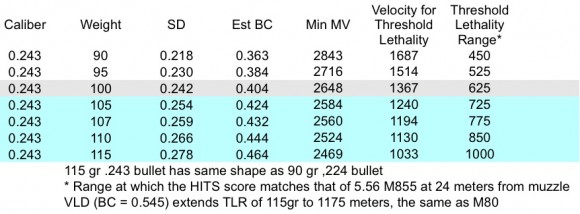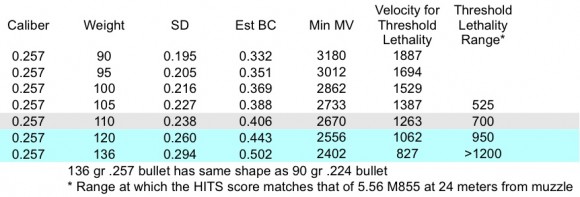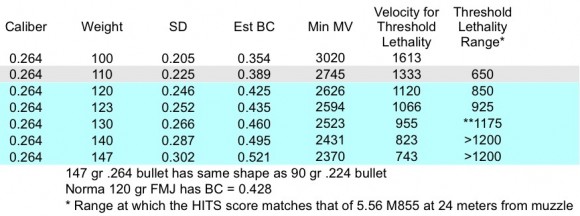| Synopsis | I. Why a New One?” | II. Terminal Effects | III. Velocities | IV. Velocities — Summary |
We learned that 6.5 mm bullets have interesting potential with respect to both the 5.56 and 7.62 NATO cartridges when we used the Part II methodology in Part III. In this section we look at how a consistent shape factor applied to .224, .243, .257, .264, and .308 bullets refines our conclusions.
Figure 1. shows the shape factors of a mix of Sierra MatchKing™ (using single value BC) and full metal jacket boattail (FMJBT) bullets. The trend line can be viewed as the average performance of the MatchKing™ shape. The variations are likely due to choices of the representative single value BC as well as evolution of the shape as new calibers and weights are implemented. The predicted shape factor coincidentally maps nicely into that of the few FMJBT examples included in the chart. This trend line was, in turn, used for estimating likely ballistic coefficients in a consistent manner for the span of bullets and weights.

Next, the ballistic coefficients for imaginary FMJBT bullets were estimated for the .224 bullet diameter. In addition the minimum muzzle velocity for at least equaling the perforation and penetration potential of the M80 7.62 NATO round were calculated. The velocity required to equal the wounding or incapacitation potential of the 5.56 NATO M855 round at 24 meters was then calculated. Finally, the maximum range at which this velocity would be attained was calculated using the previously estimated ballistic coefficients. For reference, this range for the 7.62 NATO M80 round is 1125 meters.
Some of the table rows are color-coded. Light gray represents bullet & threshold velocity combinations that have threshold wounding potential at ranges greater than 600 meters. The threshold is a HITS score equal to or greater than that of the 5.56 M855 at 24 meters. Pale green is used to indicate bullets where the nominally consistent shape factor assignment results in ballistic coefficients that are higher than that for the nominal 150 gr .308 inch diameter bullet. In other words, pale green (light teal on some screens) shows where the perforation and penetration potential will exceed that of the 7.62 NATO M80 round at all ranges because these bullets hold their velocity better.
The results for .224 bullets are tabulated in Table 1.

Table 1. Overall effectiveness potential of .224 inch diameter bullets
We observe that the velocities needed for the perforation and penetration potential are surprisingly close to those attainable by the .223 Remington (5.56 NATO) cartridge in maximum level handloads. Second, the heaviest commercially available bullet at 90 grains does not have a high enough ballistic coefficient to match the 1125 meter reach for significant wounding potential of the 7.62 NATO.
The 90 grain .224 bullet is very long, and therefore its shape was used as a standard for the heaviest bullets in .243, .257, and .264 diameters. Heavier bullets are available in .264, but these bullets are also heavier than those the 7.62 NATO M80 cartridge. For reference, a .308 caliber bullet of the same shape as the 90 grain .224 MatchKing™ would weigh 234 grains. This weight is in the range of commercially available 30 caliber bullets.
This methodology was applied to the .243 (6 mm) diameter with results shown in Table 2.

Table 2. Overall effectiveness potential of .243 inch diameter bullets
We can see that the potential significantly improves in going to this next larger caliber. Still, even for the heaviest bullets, an improvement in shape factor or higher than threshold muzzle velocity is needed to meet or exceed the reach of the 7.62 NATO in potential wounding capability.
The 25 caliber was shown in Part III apparently did not have much potential in this arena. The poor showing was the result of market forces not pushing the bullet manufactures and barrel makers to go for more capable bullets. When the unifying constraints are applied, we see that the 25 caliber performs well. Indeed, the 136 grain bullet would have the same shape as the 90 grain .224 bullet, and in our standard FMJBT configuration could out-reach the 7.62 NATO in wounding potential even though the chart uses a measly 2402 ft per second muzzle velocity.

Table 3. Overall effectiveness potential of .257 inch diameter bullets
Finally, we turn to the .264 diameter bullets. Table 4 tells us that a 130 grain .264 bullet with a muzzle velocity of 2523 feet per second would about match the reach of the 7.62 NATO. More aerodynamically efficient bullet shapes would allow this same result in lighter bullets.

Table 4. Overall effectiveness potential of .264 inch diameter bullets
The nature of this kind of assessment is that getting a final, definitive bottom line answer is like chasing an extremely elusive beast. For example, looking at the 6mm caliber, going to a VLD design or increasing the muzzle velocity to 2800 ft/sec would let this caliber exceed the 7.62 NATO reach in wounding potential. The VLD designs exist, but not yet in FMJ (or otherwise militarily suitable form). Even so, implementing a militarily suitable 115 grain VLD 6mm bullet might be less problematic for the overall goals than having to go to a much larger cartridge.
A more general observation is that any bullet that satisfies the threshold perforation and penetration threshold at the muzzle and that has a BC of at least .460 will likely have above threshold wounding potential at longer ranges than does the 7.62 NATO.
Acknowledgment: Many thanks to Stan Crist for suggestions, feedback and critical review and to Ammoguide.com member “stigma”, who is currently working a project of significant relevance for some interesting insights into this challenge.
| Synopsis | I. Why a New One?” | II. Terminal Effects | III. Velocities | IV. Velocities — Summary |

 sending...
sending...